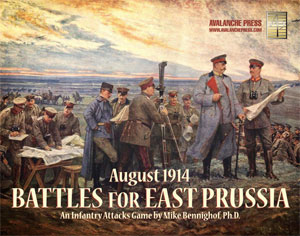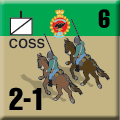| Fall of Empires, August 1914:
Armies of the Tsar
By Mike Bennighof, Ph.D.
July 2023
 In the years before the First World War, the European military press — a large and widely read subgenre at the time — commonly spoke of the “Russian steamroller.” The massive Imperial Russian Army would roll over all enemies simply based on its massive size; by implication it was a faceless, implacable force of little subtlety. In the years before the First World War, the European military press — a large and widely read subgenre at the time — commonly spoke of the “Russian steamroller.” The massive Imperial Russian Army would roll over all enemies simply based on its massive size; by implication it was a faceless, implacable force of little subtlety.
The German Schlieffen Plan recognized Russian military power and the limits of the empire's infrastructure: the French would have to be defeated quickly in order to allow Germany to turn its full power against the Russians. An Austrian assessment of 1905 projected that by 1920 Russian economic growth would have yielded military advantages that the combined Central Powers could not hope to overcome.
 But Russia’s armed strength did not rest solely in numbers. Small arms — rifles and machine guns — were very good. Artillery was of mixed quality — excellent field guns, but weaker armament in the heavier calibers both in terms of numbers and technical qualities. Cavalry training and doctrine was well ahead of that in other nations, with an emphasis on dismounted combat and a view toward long-range operations that foreshadowed later Soviet thought on armored operations. But Russia’s armed strength did not rest solely in numbers. Small arms — rifles and machine guns — were very good. Artillery was of mixed quality — excellent field guns, but weaker armament in the heavier calibers both in terms of numbers and technical qualities. Cavalry training and doctrine was well ahead of that in other nations, with an emphasis on dismounted combat and a view toward long-range operations that foreshadowed later Soviet thought on armored operations.
The Russian Army appears in the first two games in the Infantry Attacks series, August 1914 and Fall of Empires. Here's a look at what they bring to the game table:
Infantry
 
Like every other army entering the Great War, the Imperial Russian Army depended on its infantry for its striking power. The Russian infantry company had 202 enlisted soldiers, 20 non-commissioned officers and four officers; the company was divided into four platoons, each in turn made up of four sections. As in other armies, the infantry company was a purely bayonet force. Each man carried the excellent Mosin-Nagant M1891 infantry rifle, tipped by an 18-inch bayonet that regulations decreed would remain fixed at all times in combat zones.
A Russian infantry battalion had four companies, with four battalions making up a regiment. Regiments in rifle brigades had only two battalions, but otherwise followed the same tables of organization and equipment as the infantry. Other than the designation, there was no practical difference between the two types of foot soldiers and there is none in the game, either.
A Russian rifle or infantry regiment also included a machine-gun company of four platoons (two platoons in a rifle regiment), each with two Maxim machine guns. These were the ubiquitous M1910 water-cooled weapons, usually mounted on a small wheeled carriage with a splinter shield. The weapon reflected the experience of the Russo-Japanese War, and came designed for maximum mobility. A special cart accompanied the machine gun to haul ammunition, coolant and spare parts. The gunner could fire it while concealed behind the shield, using a prism to aim the weapon. It was also sited for indirect fire, though this feature seldom saw actual use.
Cavalry
 
During the years before the Great War, Russian War Minister V.A. Sukhomlinov conceived of using large cavalry forces to conduct deep penetrations of enemy territory in pursuit of strategic objectives. At the start of a war, cavalry raids would disrupt enemy mobilization, and later would strike railroads, mines and factories to destroy the enemy's ability to make war.
That didn't work out in practice — funding restrictions prevented the peacetime organization of any cavalry formation larger than a division, and those put together after mobilization never had to opportunity to conduct strategic operations. Some of Sukhomlinov’s ideas would finally see use in the Russian Civil War. The number of cavalrymen declined following the Russo-Japanese War, but in 1909-1910 the War Ministry expanded the already-large cavalry arm by half again as many horsemen.
In 1914 the Russian regular cavalry numbered 47 dragoon regiments, 17 of uhlans, 18 of hussars and 12 Guard cavalry regiments. Training had been greatly simplified following the Russo-Japanese war, with the complex parade-ground maneuvers of the last century abandoned for the Cossack “swarm” tactic — charging in a loose crescent formation. Emphasis was laid on dismounted combat, with each cavalryman issued a Mosin-Nagant carbine — and as soon as the cavalryman got off his horse, he was to immediately fix his bayonet. Just like the infantry, the dismounted cavalry was expected to close with cold steel.
Yet despite embracing those very modern ideas of cavalry deployment, in 1912 the War Ministry also ordered all regular cavalry equipped with lances.
In 1914, the Cossack hosts still retained their semi-feudal privileges even though the abolition of serfdom in 1863 had greatly reduced their relative advantages over common peasants. A Cossack paid no Imperial taxes, but in return served 18 years in the ranks — five on active duty and the remainder as a reservist.
Cossacks were not seen as suitable for a battlefield role, and many Russian cavalry officers also sneered at the quality of Cossack mounts. Each infantry corps included a Cossack regiment for screening and reconnaissance, but this meant that in many cases the rest of the corps mobilized hundreds of miles away from its attached Cossack regiment. Several of the Russian corps moved across the German border in August 1914 did so without their Cossack regiments, which were still trying to get off the trains from their home districts.
A Cossack sotny (“hundred”) traditionally had a hundred men, making it somewhat smaller than a regular cavalry squadron. The Cossack went to war with his traditional saber and the same Mosin-Nagant carbine as the regular cavalry but without a bayonet — for dismounted close combat, Cossacks used their sabers. Forty-one Cossack regiments mobilized in August 1914. By the end of the year there were 104 of them in service, plus 161 independent sotnyas.
Artillery
 
Russian artillery brigades (one per division, with a half-sized artillery “division” attached to a rifle brigade) numbered 48 field guns, in six 8-gun batteries. An infantry corps had another dozen howitzers at its disposal.
The field guns were the outstanding M1902 Putilov 76.2mm gun, which would serve in the Great Patriotic War as well. The long-barreled gun had a much greater range than comparable German and Austrian pieces, but had a rather lightly-built carriage known to break in use and a tremendous muzzle flash that made night firing a hazardous undertaking.
Howitzer batteries had one of several models of 122mm weapons: the M1904 made by Putilov, the Krupp M1909 or the Schneider M1910. The foreign-made guns were superior to the local model, and updated versions of both served in the Great Patriotic War. Some batteries also had the excellent 107mm long-range cannon, a weapon built initially by Schneider to a Russian requirement and adopted for the French and Italian armies as the 105mm cannon.
You can order August 1914 right here.
You can order Fall of Empires right here.
Infantry Attacks Package
August 1914
Fall of Empires
Franz Josef’s Armies
Winter’s Battle
Black Mountain
Retail Price: $247.95
Package Price: $200
Gold Club Price: $160
You can experience the Infantry Attacks Package right here.
This package qualifies for Gold Club Free Shipping (another $36 off!)
Sign up for our newsletter right here. Your info will never be sold or transferred; we'll just use it to update you on new games and new offers.
Mike Bennighof is president of Avalanche Press and holds a doctorate in history from Emory University. A Fulbright Scholar and NASA Journalist in Space finalist, he has published a great many books, games and articles on historical subjects; people are saying that some of them are actually good.
He lives in Birmingham, Alabama with his wife, three children, and new puppy. He misses his lizard-hunting Iron Dog, Leopold.Leopold would have rescued Samsonov.
Want to keep Daily Content free of third-party ads? You can send us some love (and cash) through this link right here.
|
